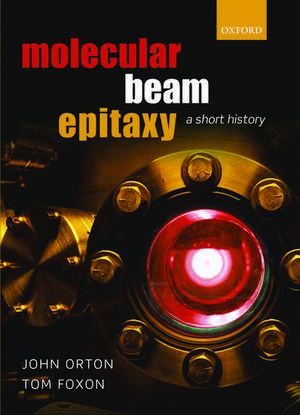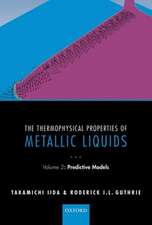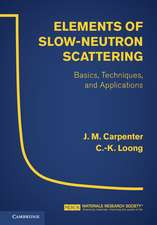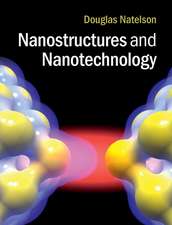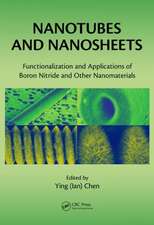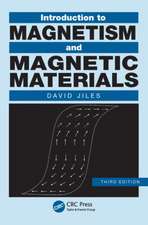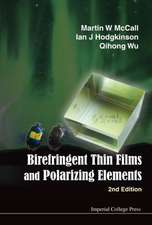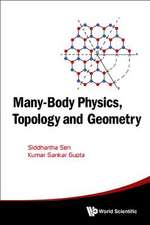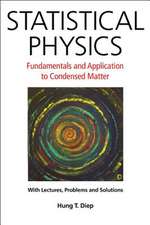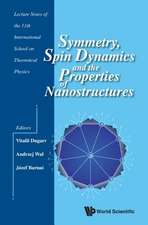Molecular Beam Epitaxy: A Short History
Autor John Orton, Tom Foxonen Limba Engleză Hardback – 24 iun 2015
Preț: 476.11 lei
Preț vechi: 646.13 lei
-26% Nou
Puncte Express: 714
Preț estimativ în valută:
91.11€ • 98.94$ • 76.54£
91.11€ • 98.94$ • 76.54£
Carte tipărită la comandă
Livrare economică 11-17 aprilie
Preluare comenzi: 021 569.72.76
Specificații
ISBN-13: 9780199695829
ISBN-10: 0199695822
Pagini: 530
Ilustrații: 152 b/w illustrations
Dimensiuni: 193 x 259 x 33 mm
Greutate: 1.28 kg
Editura: OUP OXFORD
Colecția OUP Oxford
Locul publicării:Oxford, United Kingdom
ISBN-10: 0199695822
Pagini: 530
Ilustrații: 152 b/w illustrations
Dimensiuni: 193 x 259 x 33 mm
Greutate: 1.28 kg
Editura: OUP OXFORD
Colecția OUP Oxford
Locul publicării:Oxford, United Kingdom
Recenzii
The book is written in a very clear style, which contrasts with the complexity of its subject. All the basic ideas necessary for understanding are described in the text, while well-constructed âboxesâ are provided, containing necessary mathematical equations. Experimental techniques are thoroughly described, well supported by appropriate diagrams.
A fascinating historical narrative of the development of the MBE technique, within which the authors have made key contributions. The book introduces us to the major developments and the pioneering research teams in the field, along a path which runs from the earliest experiments on vacuum deposition through to modern production epitaxy. On route, we learn about the basis of the MBE process and develop a deep understanding of the fundamentals. The book is a valuable résumé of the rapid progress made during the last half century and yet also provides an important reference work for those entering this exciting field.
Molecular Beam Epitaxy (MBE) has become a standard technique and basic equipment is available for purchase from several manufacturers, but it was not always so. The authors of this book, both renowned in the field, take us back to the origins of the subject, starting some 50 years ago when the first tentative experiments were performed, before bringing us up-to-date. It concentrates on Si and III-V semiconductors and provides details of equipment, surface processes involved in growth and some of the important devices fabricated by this method. It is essential reading for graduate students and researchers using the technique, which since its inception has spread to include metals, oxides and many other materials, principally but not exclusively, those used in electronics and optoelectronics.
This is a superbly written, comprehensive account of the development of molecular beam epitaxy and the remarkable impact this technique has had in producing complex nano-scale semiconductor devices
A fascinating historical narrative of the development of the MBE technique, within which the authors have made key contributions. The book introduces us to the major developments and the pioneering research teams in the field, along a path which runs from the earliest experiments on vacuum deposition through to modern production epitaxy. On route, we learn about the basis of the MBE process and develop a deep understanding of the fundamentals. The book is a valuable résumé of the rapid progress made during the last half century and yet also provides an important reference work for those entering this exciting field.
Molecular Beam Epitaxy (MBE) has become a standard technique and basic equipment is available for purchase from several manufacturers, but it was not always so. The authors of this book, both renowned in the field, take us back to the origins of the subject, starting some 50 years ago when the first tentative experiments were performed, before bringing us up-to-date. It concentrates on Si and III-V semiconductors and provides details of equipment, surface processes involved in growth and some of the important devices fabricated by this method. It is essential reading for graduate students and researchers using the technique, which since its inception has spread to include metals, oxides and many other materials, principally but not exclusively, those used in electronics and optoelectronics.
This is a superbly written, comprehensive account of the development of molecular beam epitaxy and the remarkable impact this technique has had in producing complex nano-scale semiconductor devices
Notă biografică
John Orton won an Exhibition at Magdalen College, Oxford, where he obtained an honours degree in Physics, followed by a D Phil, with a thesis on Electron Spin Resonance in magnesium oxide. He joined Mullard (later Philips) Research Laboratories in 1960 to work on the development of the microwave maser. In 1968 he lead the Group responsible for developing compound semiconductor devices and continued to work in various aspects of semiconductor research, one of his principal interests being in the use of Molecular Beam Epitaxy to grow low-dimensional semiconductor structures. from 1989 to 1991 he was Visiting Professor in Nottingham. He was active within the Institute of Physics, serving on the Solid State Physics Committee, the Semiconductor Physics Committee and on the Editorial Board of J Phys D (Applied Physics). In 1991 he took up the Chair of Optoelectronics in the Department of Electrical and Electronic Engineering at the University of Nottingham.Tom Foxon obtained his B.Sc. in Physics at King's College, London and his Ph.D. in Materials Science in, at Battersea College. In 1969 he joined the Mullard (now Philips) Research Laboratories where he started the first work in Europe on MBE growth of III-V compounds. In 1987 he was appointed as a Visiting Professor in the Physics Department of the Technical University in Eindhoven, the Netherlands. In October 1991, he was appointed to his present post as a Professor in the School of Physics and Astronomy at the University of Nottingham, where in collaboration with Prof John Orton he set up the first work in Europe on the growth of group III-Nitride by MBE. He is currently Chairman of the UK Nitride Consortium, a member of the UK MBE group, a member of the EPSRC Peer Review College, a Fellow of the IOP, was President of the British Association for Crystal Growth (2006-2009) and was elected a Fellow of the Royal Society in 2006.
